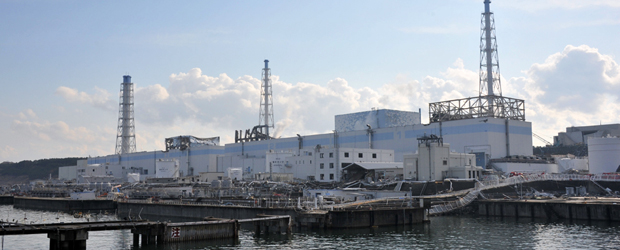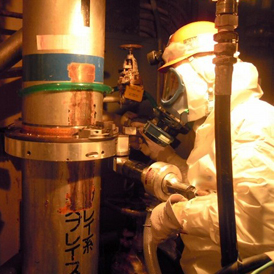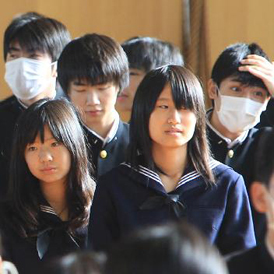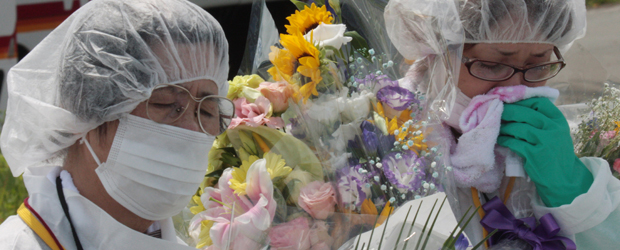Fukushima’s nuclear surprises
Nearly eight months after nuclear reactors at Fukushima melted down and exploded they are still throwing up surprises, writes Channel 4 News Science Correspondent Tom Clarke.

Last week, in the Tokyo commuter town of Kashiwa, officials found a radiation hotspot in the soil around a leaking drain nearly as high as those which prompted the evacuation of towns much nearer to the stricken nuclear plant.
It didn’t make sense: the majority of fallout was over rural areas to the north west of the Fukushima plant. Kashima, a town of 400,000, is 80 miles due south. The hunt is now on for further hotspots around drain and sewer systems.
Another surprise came this week when a new analysis concluded the disaster released twice as much radioactivity into the atmosphere as previously estimated.
Both are examples of how the true impact of the Fukushima crisis is still hard for experts to judge, not just on the health and livelihoods of people from the region but for the nuclear industry in Japan, and the future of nuclear power worldwide.

Progress at Fukushima
Each day at Fukushima there are still 2,500 to 3000 workers slowly clearing up the mess. Work is hindered by pieces of intensely radioactive debris scattered across the site by the explosions — in some parts levels of radiation are high enough to kill in minutes.
Progress has been made: all three of the reactors that melted down are now being automatically cooled by seawater being pumped through them.
Tepco, the plant’s operator, has just finished installing a highly sophisticated water decontamination system. This is taking about 10,000 tonnes of water irradiated during the cooling process and evaporating it to remove radioactive contamination which is then stored on site. But there is still around 120,000 tonnes of highly contaminated water trapped in tunnels beneath the plant. Work can only begin on that once the reactors have cooled down.
Tepco says the reactors will be made safe in a state called “cold shut down” by the end of the year. However, given the damage to the reactor cores and the melted fuel within, observers doubt that the target will be met. “That fuel will remain hot and continue to do so for many years to come,” said veteran Greenpeace nuclear campaigner Shaun Burnie.
The picture in the contaminated areas around the plant is less clear. The worst affected towns and villages to the northwest of the plant have all been evacuated. Fortunately only about 20 per cent of the fallout from the plant ended up on the land.
Read more: Fukushima – where life stopped in an instant

The physical and psychological fallout
Most of the long-lived radiation is due to caesium isotopes – a breakdown product of uranium nuclear fuel. Caesium has a half-life of 30 years.
“My guess is that there are some areas where people won’t be able to return for decades,” said Jim Smith, who has studied the ecological legacy of the Chernobyl disaster.
A particular problem is that caesium is absorbed by plants and animals. Farming food crops and livestock in some areas will remain impossible. That’s a major problem for parts of Fukushima prefecture. Fruit and beef production were some of their economic mainstays.
Produce from uncontaminated parts of the region are being shunned by consumers because of the fear of contamination.
I’ve heard of school children being shunned by their schoolmates because they are perceived to be contaminated. Jim Smith
On the up-side caesium can be cleaned up. It sticks to soil particles and so can be skimmed off using bulldozers or ploughs.
Last week authorities in Fukushima City started pressure hosing and scrubbing 110,000 homes and businesses with the highest levels of contamination. But any clean-up will be limited. Not only is the process costly, so too is the long term storage of potentially enormous quantities of radioactive soil and debris.
The direct affects on human health though, are expected to be minor. Japanese authorities were quick to ban food, especially milk, and issue iodine tablets. It is expected that an epidemic of thyroid cancer – anticipated in Belarus as a result of the Chernobyl disaster – will not happen in Japan.
But one lesson from Chernobyl is that the social and psychological damage from fleeing radioactive fallout can be far worse. Leaving homes and farms behind takes a heavy emotional toll – so can the stigma of radioactivity.
“I’ve heard of school children evacuated from around the plant being shunned by their schoolmates because they are perceived to be contaminated,” said Smith.
“We saw the same after Chernobyl.”
Read more: Fukushima – is any job worth the risk?

What next for nuclear?
After the disaster Japan’s then prime minister ordered a moratorium on nuclear power. New impetus was given to renewable energy and fossil fuel generation.
In September the country abandoned plans to build a new fleet of “fast breeder” reactors. But given the energy needs of its weakened economy widespread public opposition has now given way to an acceptance that Japan will source its power from nuclear for a long time to come – even if new plants don’t get built.
But will there be a lasting impact on plans for fleets of new nuclear plant in places like the Middle and Far East and parts of Europe? The catastrophic engineering failure at Fukushima was not supposed to happen.
In response to the crisis the US and China are conducting safety reviews of nuclear plants. Switzerland, Italy and Germany have abandoned nuclear power altogether.
Early on, many analysts believed the reputation the “new nuclear” industry had fought hard to rebuild in recent years would never survive.
But experts like Malcolm Grimston, a nuclear industry analyst at Imperial College in London, thinks the damage was not as great as predicted. “The lasting effect of Fukushima was not as great as we assumed at the time.
One of the key issues is whether there was damage to the plant by the earthquake itself. Shaun Burnie
“The key question is, what will the impact be on the economics of new nuclear?”
Cracks are beginning to appear. German engineering giant Siemens – which co-designed many of Europe’s reactors — announced last month it was pulling out of nuclear power. And German energy major RWE abandoned plans to build two new nuclear plants in the UK.
New civilian reactors will most likely get built in China, the US and the UK – though not as quickly as first planned. But their future could still be affected by the Fukushima disaster. The true nature of the damage – and when it was caused – is only likely to emerge as workers get closer to the highly radioactive reactor cores.
“One of the key issues is whether there was damage to the plant by the earthquake itself,” said Shaun Burnie.
Initial analyses have all but ruled this out. But if the design of the nuclear plant was seriously damaged by shaking – not just by the 50ft tsunami wave – it could have major implications for the designs of new reactors planned for the rest of the world, possibly even pushing their costs beyond the realms of economic reality.
-
Latest news
-
India’s ‘YouTube election’: Influencers enlisted to mobilise youth vote6m

-
Putin denies plans to capture Ukrainian city of Kharkiv3m

-
Plaid Cymru ends co-operation agreement with Welsh Labour government4m

-
Infected blood scandal: Government was warned years before taking action6m

-
Displaced in Gaza have to ‘start from Zero’ many times over, says Gaza NGO director3m

-





